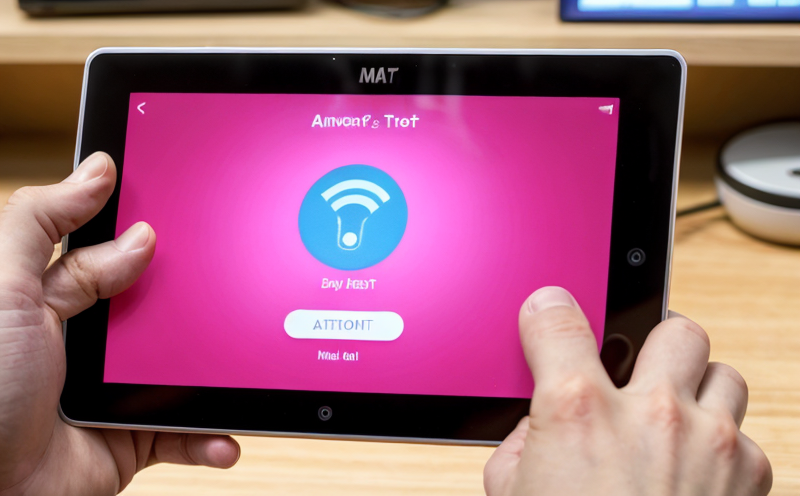Short Circuit Protection Testing in Smart Devices
Short circuit protection testing is a critical aspect of ensuring the safety and reliability of smart consumer devices. In today's interconnected world, where IoT (Internet of Things) devices are becoming more prevalent, protecting against short circuits is essential to prevent electrical hazards and ensure product longevity.
Smart connected devices often face a variety of environmental challenges that can lead to shorts or other faults in the circuitry. These could include physical damage from drops or impacts, exposure to moisture, or even internal wear and tear over time. Short circuit protection testing ensures that these devices are robust enough to withstand such stresses without compromising safety.
The goal of this test is to identify any vulnerabilities within the device's power supply and electrical components that could lead to a short circuit. This involves simulating real-world conditions where a short might occur, such as when two conductive parts come into contact unexpectedly or due to manufacturing defects. By doing so, manufacturers can implement necessary improvements early in the product development cycle.
In addition to protecting users from potential injuries caused by electrical hazards, short circuit protection also helps protect devices themselves from damage. For instance, a poorly designed device may experience overheating or permanent failure if it does not have adequate safeguards against excessive current flow. Properly implemented short circuit protection can help extend the lifespan of smart consumer electronics by reducing the likelihood of premature failures.
Testing methodologies vary depending on the type and complexity of the device being tested, but typically involve applying controlled amounts of overcurrent or voltage stress to key points within the circuitry while monitoring performance indicators like temperature rise, leakage current, and resistance changes. Compliance with relevant international standards such as IEC 62368-1 ensures that tests are conducted consistently across different manufacturers.
During testing, it is important to consider not only how individual components behave under stress but also the overall system response. This holistic approach helps identify systemic issues that could be overlooked if only isolated elements were examined. For example, a short circuit might start in one part of the device but propagate through interconnected circuits before causing damage elsewhere.
Testing laboratories play a crucial role by providing accurate and reliable results based on standardized procedures. They use sophisticated equipment capable of simulating various fault conditions accurately while maintaining precise control over variables such as temperature, humidity, and duration of exposure. The data collected from these tests is invaluable for refining designs and improving overall product safety.
Scope and Methodology
The scope of short circuit protection testing covers all aspects related to the design, manufacturing, and performance evaluation of smart consumer devices. It ensures that these products meet stringent safety requirements set forth by relevant regulatory bodies and industry standards.
- Testing is performed on various types of connected devices including wearables, home appliances, and entertainment systems.
- The methodology follows established protocols outlined in international standards such as IEC 62368-1 to guarantee consistency and accuracy.
- Key components examined include power supplies, circuit breakers, fuses, and other protective elements integrated into the device.
The testing process involves multiple stages starting with initial design reviews followed by prototype evaluation. Once prototypes pass this phase successfully, mass production units undergo rigorous testing under simulated fault conditions to ensure they perform reliably even when exposed to potential hazards.
Competitive Advantage and Market Impact
Adopting comprehensive short circuit protection measures can give companies a significant competitive edge in the market. Not only does it enhance consumer trust, which is vital for brands operating in highly regulated industries like electronics and IoT devices; it also reduces the risk of recalls or safety-related incidents that could damage brand reputation.
From a business perspective, implementing robust short circuit protection strategies can lead to cost savings by minimizing warranty claims and product returns. It also supports sustainable development goals by encouraging responsible use of resources throughout the product lifecycle.
Use Cases and Application Examples
| Device Type | Testing Scenario | Expected Outcome |
|---|---|---|
| Smartwatch | Simulating accidental water immersion followed by rapid temperature cycling. | The watch should continue functioning correctly without any signs of short circuiting or degradation in performance. |
| Home security camera | Exposing the device to direct lightning strikes and measuring current flow through protective circuits. | The camera must maintain operational integrity, ensuring that no permanent damage occurs due to the surge. |
| Educational toy robot | Subjecting the toy to repeated drops from varying heights while checking for signs of internal shorts. | The toy should remain fully operational after each fall, demonstrating effective short circuit protection mechanisms. |
- Incorporating advanced materials that provide superior insulation properties against electrical leakage.
- Implementing microcontroller-based systems capable of detecting and responding to potential faults in real-time.
- Utilizing machine learning algorithms to predict likely failure points based on historical usage patterns.





